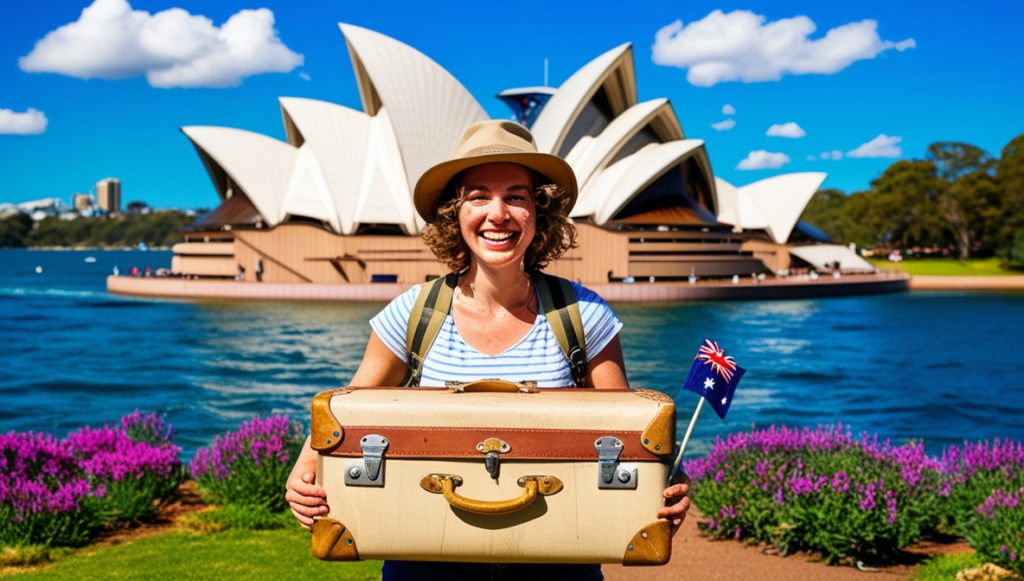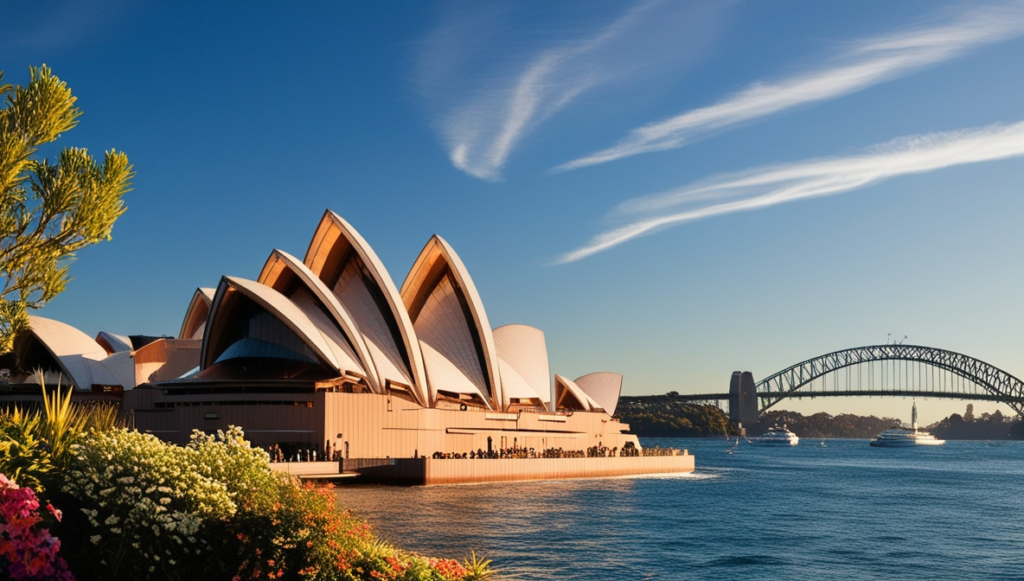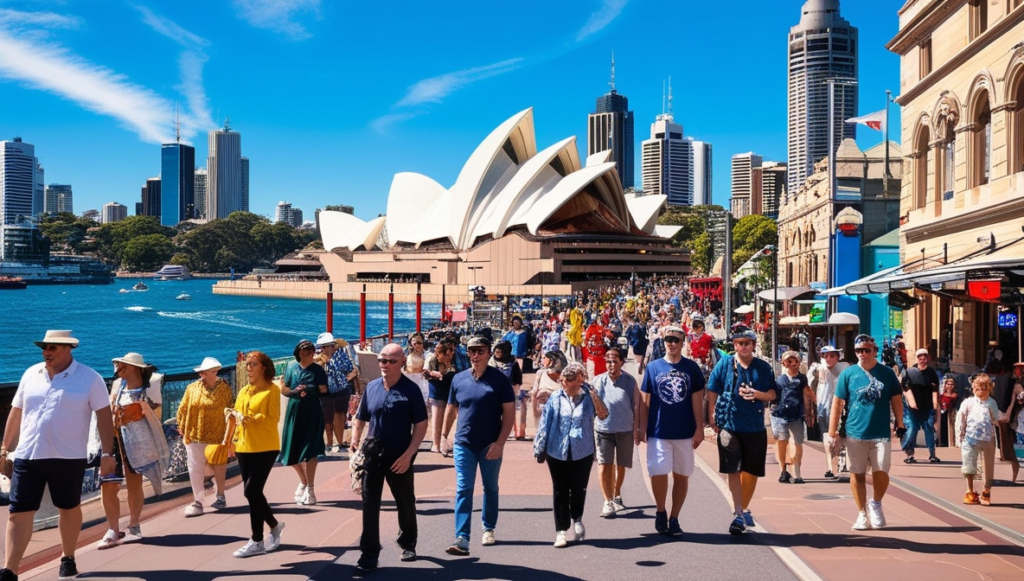Introduction
Traveling to Australia From the iconic Sydney Opera House to the vast outback and the breathtaking Great Barrier Reef, Australia promises an unforgettable experience for every traveler. Whether you’re seeking adventure, relaxation, or an opportunity to immerse yourself in diverse traditions, this extraordinary destination has something to offer. This article will guide you through everything you need to know about traveling to Australia, helping you plan a trip that is as seamless as it is memorable.

1. Cairns and the Great Barrier Reef Region
Description: The Great Barrier Reef and the Daintree Rainforest are two UNESCO World Heritage sites that can be reached from Cairns, which is tucked away in tropical North Queensland. This region boasts lush greenery, turquoise waters, and vibrant marine ecosystems.
Best Time to Visit: June to October for pleasant weather, and December to February for turtle nesting season.
Highlights: Explore secluded beaches, enjoy snorkeling or diving in world-class reef sites, and witness the rare convergence of rainforest and reef ecosystems.
2. Sydney
Description: Known for its sparkling harbor and iconic landmarks, Sydney offers a mix of urban vibrancy and natural beauty. The Sydney Opera House, Harbour Bridge, and sandy beaches like Bondi and Coogee draw millions annually.
Best Time to Visit: October to May for sun-filled days; June to September for the whale migration season.
Highlights: Take in panoramic views from the Harbour Bridge, surf at Bondi Beach, and enjoy the city’s buzzing nightlife.
3. Uluru (Ayers Rock)
Description: This awe-inspiring red sandstone monolith in Central Australia is both a natural wonder and a cultural treasure. It’s sacred to the Anangu people and offers unique desert experiences.
Best Time to Visit: June to August for cooler desert conditions.
Highlights: Witness the magical “Field of Light” art installation, dine under the stars, and trek or cycle around the base of this iconic landmark.
4. Melbourne
Description: A cultural hub, Melbourne is famous for its vibrant arts scene, rooftop bars, and culinary diversity. It’s also a gateway to the scenic Great Ocean Road.
Best Time to Visit: November to March for festivals and sunny weather.
Highlights: Stroll along laneways adorned with street art, enjoy coastal drives, and experience local festivals like the Australian Open.
5. Perth and Margaret River
Description: Perth combines urban charm with nature, while the Margaret River region offers vineyards, forests, and pristine beaches.
Best Time to Visit: September to November for wildflower blooms; January to March for festivals.
Highlights: Savor award-winning wines, explore towering karri forests, and relax on untouched beaches.
6. Kangaroo Island
Description: A sanctuary for wildlife enthusiasts, Kangaroo Island is home to native species like kangaroos, sea lions, and echidnas.
Best Time to Visit: December to February for summer activities; winter months for lush greenery and whale sightings.
Highlights: Visit Seal Bay Conservation Park, enjoy local wines, and capture stunning coastal views.
7. Kakadu National Park
Description: A UNESCO World Heritage site, Kakadu offers a stunning blend of wetlands, waterfalls, and Aboriginal rock art.
Best Time to Visit: May to October for dry, cooler conditions.
Highlights: Cruise the Yellow Water Billabong, marvel at Jim Jim Falls, and experience rich cultural history through ancient rock art.
8. Hobart, Tasmania
Description: Tasmania’s capital is a blend of history, fine dining, and outdoor escapades. Nearby, Mount Wellington and MONA offer unique attractions.
Best Time to Visit: December to March for warm weather; winter for the Southern Lights.
Highlights: Savor fresh seafood, trek alpine trails, and explore the Museum of Old and New Art (MONA).
9. Gold Coast
Description: A paradise for beachgoers and thrill-seekers, the Gold Coast offers sunny beaches, lush rainforests, and family-friendly attractions.
Best Time to Visit: January to May and August to December for ideal weather.
Highlights: Enjoy theme parks, surfing, and the vibrant nightlife of Surfers Paradise.
10. Byron Bay
Description: A laid-back coastal town known for its scenic beauty, Byron Bay attracts surfers, artists, and celebrities alike.
Best Time to Visit: All year round, depending on personal preferences.
Highlights: Surf at pristine beaches, whale watching from the lighthouse, and immerse yourself in the town’s bohemian charm.

Tips for traveling to Australia
- Plan for Seasons:
Australia’s climate varies widely due to its size. Northern regions like Queensland have tropical weather, while the southern states experience distinct seasons. Research the climate of your destination to pack appropriately and make the most of your trip. - Respect Wildlife and Nature:
Australia is renowned for its unique biodiversity. Whether you’re snorkeling in the Great Barrier Reef or hiking in Kakadu National Park, follow local guidelines to protect these delicate ecosystems. - Travel Insurance is a Must:
Given the vastness and variety of activities available, travel insurance can safeguard against unexpected incidents, whether medical or logistical. - Explore Beyond Major Cities:
While cities like Sydney and Melbourne offer urban delights, regional destinations such as the Great Ocean Road, Kangaroo Island, or Tasmania provide enriching, off-the-beaten-path experiences. - Indulge in Local Cuisine:
From fresh seafood in coastal towns to wine-tasting in Margaret River or Yarra Valley, Australian culinary offerings are diverse and unforgettable. Don’t miss unique options like kangaroo meat or Tim Tams.
Final Thoughts
Australia’s rich blend of natural wonders, cultural landmarks, and thrilling adventures makes it a bucket-list destination for travelers worldwide. By visiting its must-see destinations and embracing its diverse experiences, you’ll create memories that last a lifetime. Whether it’s the serene beaches of Byron Bay, the awe-inspiring red sands of Uluru, or the vibrant cityscapes of Sydney and Melbourne, Australia promises an unforgettable journey.
Conclusion
traveling to Australia offers an unforgettable adventure, rich with diverse landscapes, vibrant cities, and unique wildlife. Whether you’re exploring the bustling streets of Sydney or hiking through the rugged beauty of the Outback, the country provides endless opportunities for discovery. A seamless and pleasurable trip can be ensured by preparation, familiarity with the local way of life, and knowledge of important travel advice. So, if you’re considering traveling to Australia, make sure to prioritize your safety, pack accordingly for varying climates, and embrace the incredible experiences this vast and fascinating destination has to offer.

Frequently Asked Questions About Traveling to Australia
1. What is the best time to visit Australia?
The best time to visit depends on the region and your activities. For example:
- Summer (December to February): Great for beaches and coastal areas.
- Winter (June to August): Perfect for exploring the Outback or skiing in the Snowy Mountains.
- Spring and Autumn (September to November and March to May): Ideal for most regions, offering mild weather and fewer crowds.
2. Do I need a visa to travel to Australia?
Yes, most travelers need a visa to enter Australia. Options include the Electronic Travel Authority (ETA) or Visitor Visa (subclass 600). Check your eligibility and apply in advance through the Australian immigration website.
3. What are the top cities to visit in Australia?
Must-visit cities include:
- Sydney: Famous for the Opera House and Harbour Bridge.
- Melbourne: Known for art, culture, and its café scene.
- Brisbane: A gateway to the Great Barrier Reef and Gold Coast.
- Perth: Offers beautiful beaches and proximity to Rottnest Island.
4. How safe is it to travel to Australia?
Australia is generally very safe for tourists. However:
- Be cautious of wildlife and adhere to safety guidelines in remote areas.
- Protect yourself from the sun with sunscreen, hats, and UV-blocking clothing.
- Avoid swimming in areas with strong currents or where jellyfish are present.
5. Is Australia expensive to visit?
Australia can be pricey, but costs vary depending on your travel style. Budget travelers can save by:
- Staying in hostels or Airbnbs.
- Using public transportation.
- Cooking meals instead of dining out.
6. What should I pack for a trip to Australia?
Pack essentials based on the season and activities planned. Key items include:
- Comfortable walking shoes.
- Swimwear and beach gear.
- A hat, sunglasses, and sunscreen.
- Wear layers in the winter or light garments in the summer..
7. What unique experiences should I not miss in Australia?
- Snorkeling or diving in the Great Barrier Reef.
- Watching the sunrise or sunset at Uluru.
- Touring the vineyards in the Barossa Valley.
- Encountering wildlife like kangaroos, koalas, and Tasmanian devils.
8. Can I drive in Australia with a foreign license?
Yes, you can drive with a valid foreign license. However, it must be in English or accompanied by an International Driving Permit (IDP). Keep in mind that Australians use the left side of the road when driving.
9. How do I stay connected to the internet in Australia?
You can buy a local SIM card from providers like Telstra, Optus, or Vodafone. Free Wi-Fi is also available at many cafes, hotels, and city public areas.
10. What currency is used in Australia?
Australia uses the Australian Dollar (AUD). Credit and debit cards are widely accepted, but carrying some cash for smaller towns or markets is a good idea.

